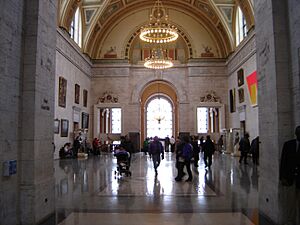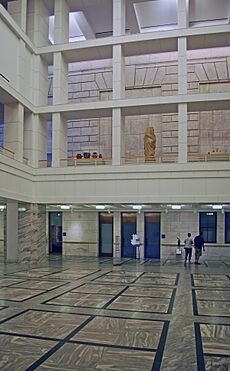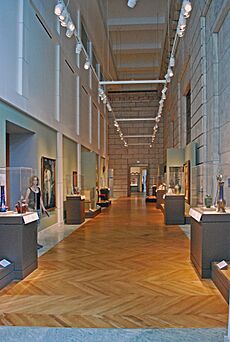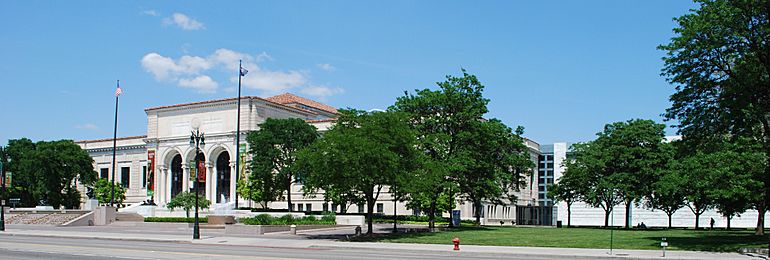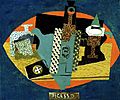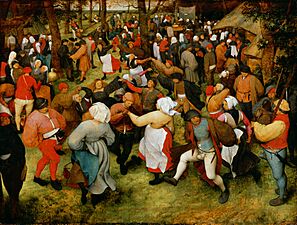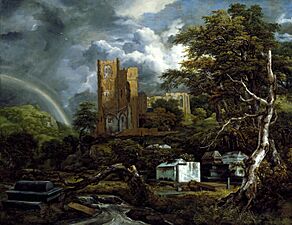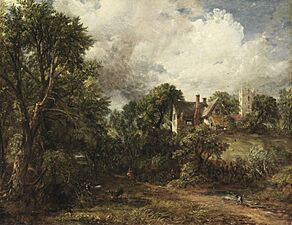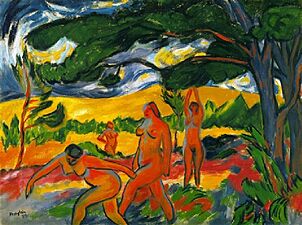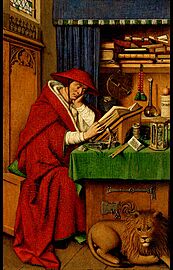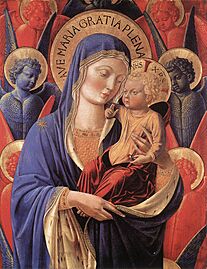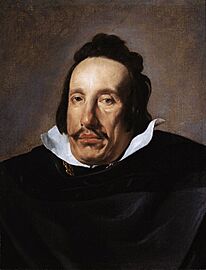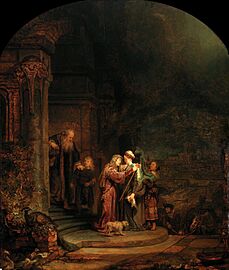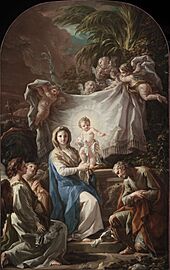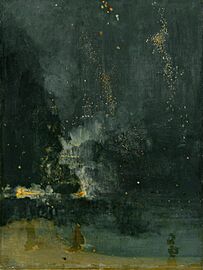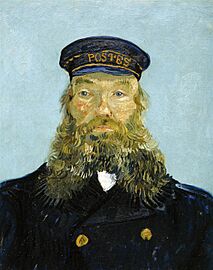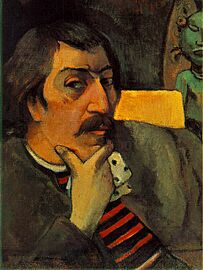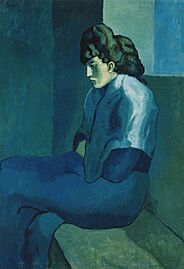Detroit Institute of Arts facts for kids
 |
|
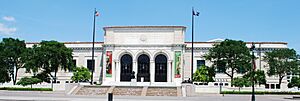 |
|
| Established | 1885 |
|---|---|
| Location | 5200 Woodward Avenue Detroit, Michigan |
| Type | Art museum |
| Collection size | 65,000 works |
| Visitors | 677,500 (2015) |
| Public transit access | QLine: Warren Avenue/Ferry Street DDOT, SMART |
The Detroit Institute of Arts (DIA) is a fantastic art museum in Midtown Detroit, Michigan. It holds one of the biggest and most important art collections in the United States. Imagine over 100 galleries filled with amazing art from all over the world!
The museum covers a huge area, about 658,000 square feet. A big renovation in 2007 made it even larger. The DIA's collection is like a world tour of art, from ancient Egyptian treasures to modern masterpieces. Experts say it's one of the top six museums in the U.S. for its wide range of art. The art here is worth billions of dollars!
The DIA campus is in Detroit's Cultural Center Historic District. It's about 2 miles north of downtown, right across from the Detroit Public Library. The museum building itself is very special. It was designed by Paul Philippe Cret and is made of beautiful white marble.
The museum's first painting was given in 1883. Today, its collection has over 65,000 works. Hundreds of thousands of people visit the DIA every year. It's one of the most visited art museums in the world. The DIA also has a large theater, a hall for talks, an art library, and a special lab to fix old art. In 2023, readers of USA Today voted the Detroit Institute of Arts the best art museum in the United States!
Contents
Exploring the Art Collections

The DIA has 100 galleries with art from many different cultures and times. One of the most famous parts is Diego Rivera's Detroit Industry frescoes. These huge paintings cover the walls of the central court. They show scenes of factory workers and machines in Detroit.
The museum also has an impressive collection of American art. Many experts rank it as one of the top three American painting collections in the country. You can see works by famous American artists like Mary Cassatt, Winslow Homer, Georgia O'Keeffe, and Andy Warhol. The collection includes paintings, sculptures, and decorative arts from the 1700s to today.
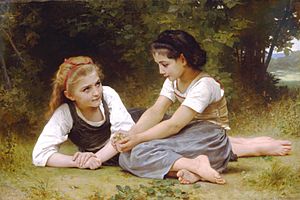
The DIA also has many amazing European artworks. You can see paintings by Pieter Bruegel the Elder, Jan van Eyck, Giovanni Bellini, and Rembrandt van Rijn. The museum was one of the first in America to buy paintings by Vincent van Gogh and Henri Matisse in 1922. Other famous European artists include Claude Monet, Edgar Degas, Paul Cézanne, and Pablo Picasso. One very popular painting is The Nut Gatherers by William-Adolphe Bouguereau.
Beyond American and European art, the DIA has art from ancient Greece, Rome, Egypt, and Mesopotamia. There are also beautiful collections of Islamic, African, and Asian art. In 2010, the museum opened a new gallery just for puppets! It features hand, shadow, and string puppets from around the world.
Past Art Exhibitions
The DIA often hosts special art shows. These exhibitions bring unique artworks to Detroit for a limited time. Here are a few examples of past shows:
- Artists' Take on Detroit: Projects for the Tricentennial (2001): This show celebrated Detroit's 300th birthday. It featured 10 art projects by 15 artists, including videos, photos, and sculptures.
- Over the Line: The Art and Life of Jacob Lawrence (2002): This exhibit showcased the work of African American artist Jacob Lawrence. It included pieces from his famous Migration series.
- Degas and the Dance (2002-2003): This show featured over 100 works by Edgar Degas. It explored his art inspired by 19th-century Parisian ballet dancers.
- Magnificenza! The Medici, Michelangelo and The Art of Late Renaissance Florence (2003): This exhibit displayed art from a powerful Italian family, the Medici. It showed their connection to Michelangelo and art in Florence.
- Yoko Ono's Freight Train (2003-2005): This outdoor exhibit featured a German boxcar with bullet holes. It was created by artist Yoko Ono.
- Camille Claudel and Rodin: Fateful Encounter (2005-2006): This exhibit showed sculptures by Auguste Rodin and Camille Claudel. It explored their artistic relationship.
- Annie Leibovitz: American Music (2006-2007): This show featured photographs by Annie Leibovitz. It included portraits of famous musicians like B.B. King and Johnny Cash.
- Ansel Adams (2007): This exhibit displayed over 100 black and white photographs by Ansel Adams. His famous landscape photos were a highlight.
- Van Gogh in America (2022): This major exhibition celebrated 100 years since the DIA bought its first Vincent van Gogh painting. It was the largest Van Gogh show in America in a generation.
Museum Architecture and Design
The DIA building is a work of art itself! In the 1920s, a group chose Paul Philippe Cret to design the new museum. The original building has a beautiful Beaux-Arts and Italian Renaissance style. Its main material is white marble. The cornerstone was laid in 1923, and the museum opened in 1927.
A famous sculpture, The Thinker by Auguste Rodin, was donated in 1922. It was first inside the museum. Later, it was moved outside, facing Woodward Avenue and the Detroit Public Library.
Building Expansions and Updates
Later, in 1966 and 1971, north and south wings were added. These were designed by Gunnar Birkerts. They were originally made of black granite. In 2007, the museum had a big renovation and expansion. Architects like Michael Graves helped with this project. The north and south wings were refaced with white marble, matching the original building. This added 58,000 square feet to the museum.
The building also includes a 16th-century French Gothic chapel. This chapel was a gift from Ralph H. Booth.
Famous Artworks Inside the Building

In 1932, Edsel Ford asked Diego Rivera to paint murals for the DIA. These huge frescoes are called Detroit Industry, or Man and Machine. They are in a large central courtyard, which was later covered with a roof. These murals are considered very important artworks and a special part of the museum.
The building also features beautiful iron work by Samuel Yellin. You can also see special tiles from Pewabic Pottery.
A Look at DIA's History
The idea for the museum started in 1881. A newspaper owner named James E. Scripps toured Europe and wrote about art. His stories were so popular that a newspaper manager, William H. Brearley, organized an art exhibit in 1883. It was a huge success!
Brearley convinced many important Detroit citizens to help create a permanent museum. It was first called the Detroit Museum of Art. Many wealthy people, including Scripps and Edsel Ford's family, donated money and art. By 1888, the Detroit Museum of Art opened with over 70 artworks.
In 1919, the museum's name changed to the Detroit Institute of Arts. A new, larger building was needed for the growing city. The current DIA building on Woodward Avenue opened on October 7, 1927.
Growth and Challenges
In 1919, the museum became part of the City of Detroit. This meant it received money from the city. A German art expert, Wilhelm Valentiner, became the director. Under his leadership, the DIA's collection grew a lot. The museum became the first in the U.S. to buy a Vincent van Gogh and a Henri Matisse painting in 1922.
Valentiner also changed how art was displayed. Instead of grouping all paintings together, he organized art by country and time period. This was a new idea for museums!
Wealthy families like the Fords and Dodges continued to support the museum. Robert Hudson Tannahill also gave many artworks, including pieces by Paul Cézanne and Vincent van Gogh.
In the 1970s and 80s, Detroit faced financial problems. The state of Michigan stepped in to help fund the museum. In 1998, a private group, the Founder's Society, took over managing the museum. The city still owned the building and the art.
Protecting the Collection
The DIA has been careful about the history of its art. In 1949, it was one of the first museums to return art that had been stolen by the Nazis during World War II. In 2002, the museum found out a painting it wanted to buy had also been stolen by the Nazis. They contacted the original owners, paid them, and added the painting to their collection.
In 2006, a 12-year-old boy accidentally damaged a painting with chewing gum. The museum's experts successfully cleaned and restored the artwork.
Becoming Independent
In 2014, during Detroit's bankruptcy, there was a concern that some of the museum's art might be sold. To prevent this, a "grand bargain" was made. The museum, private foundations, and the state of Michigan raised $820 million. This money helped city workers' pensions. In return, the city transferred ownership of the art and building to the non-profit Detroit Institute of Arts, Inc. This made the museum an independent non-profit again, like it was before 1919.
Today, the DIA is financially strong. In 2020, voters in nearby counties approved a special tax to help fund the museum for 10 years. This means residents of Wayne, Oakland, and Macomb counties get free general admission!
Museum Leadership
Directors of the DIA
The Detroit Institute of Arts has had many leaders throughout its history. Here are some of the people who have served as director:
- John W. Dunsmore (1888-1891)
- Armand H. Griffith (1891-1913)
- Clyde Huntley Burroughs (1917-1924)
- Wilhelm Valentiner (1924-1945)
- Edgar Preston Richardson (1945-1962)
- Willis F. Woods (1962-1973)
- Frederick J. Cummings (1973-1984)
- Samuel Sachs, II (1985-1997)
- Graham W. J. Beal (1999-2015)
- Salvador Salort-Pons (2015–Present)
Salvador Salort-Pons is the current director. He was born in Madrid, Spain. Before becoming director, he led the European Art Department at the DIA. He has a doctorate in art history and an MBA. He became director in 2015 after Graham Beal retired.
Museum Events and Community
The DIA is more than just a place to see art. It also hosts many events! These include major art exhibitions in its theater. There are also annual fundraising galas. The "Fash Bash" is a popular fashion event that showcases the latest trends.
Many visitors to the DIA come from the surrounding counties of Wayne, Macomb, and Oakland. The museum's attendance grew from 429,000 in 2011 to about 630,000 in 2014. Thanks to the support from local voters, residents of these counties enjoy free general admission.
Images for kids
-
Pablo Picasso, 1916, L'anis del mono (Bottle of Anis del Mono)
Gallery
-
Pieter Bruegel the Elder, The Wedding Dance, 1566
-
Jacob Isaakszoon van Ruisdael, The Jewish Cemetery, 1657
-
Henry Fuseli, The Nightmare, 1781
-
John Constable, The Glebe Farm, 1827
-
Edgar Degas, Violinist and Young Woman, 1870–1872
-
Paul Cézanne - Baigneuses (Detroit).jpg
Paul Cézanne, Bathers, 1879
-
Max Pechstein, 1911, Under the Trees (Akte im Freien), oil on canvas, 73.6 x 99 cm (29 x 39 in)
-
Jan van Eyck (workshop), Saint Jerome in His Study, 1442
-
Benozzo Gozzoli, Madonna and Child, c. 1460
-
Lucas Cranach the Elder, Saint Christopher, 1518–20
-
Diego Velázquez, Portrait of a Nobleman, 1623
-
Rembrandt van Rijn, The Visitation, 1640
-
Corrado Giaquinto, Rest on the flight to Egypt, 1764–65
-
John Singleton Copley, Watson and the Shark, 1782
-
James Abbott McNeill Whistler, Nocturne in Black and Gold – The Falling Rocket, c. 1872–1877
-
Vincent van Gogh, Self-Portrait with Straw Hat, 1887
-
Vincent van Gogh, Portrait of the Postman Joseph Roulin, 1888
-
Paul Gauguin, Portrait of the Artist with the Idol, 1893
-
Pablo Picasso Femme assise (Melancholy Woman), 1902–03
-
Richard James Wyatt Girl Bathing.JPG
Richard James Wyatt, Girl Bathing, marble, 1830–35
-
Jean-Baptiste Carpeaux, The Smoker, 1863
More to See
- Cranbrook Art Museum
- Edsel and Eleanor Ford House
- List of art museums
- University of Michigan Museum of Art
See also
 In Spanish: Instituto de Artes de Detroit para niños
In Spanish: Instituto de Artes de Detroit para niños


